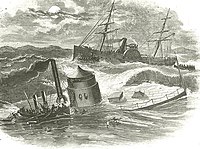
USS Minnesota was a wooden steam frigate in the United States Navy. Launched in 1855 and commissioned eighteen months later, the ship served in east Asia for two years before being decommissioned. She was recommissioned at the outbreak of the American Civil War and returned to service as the flagship of the North Atlantic Blockading Squadron.

USS Santee was a wooden-hulled, three-masted sailing frigate of the United States Navy. She was the first U.S. Navy ship to be so named and was one of its last sailing frigates in service. She was acquired by the Union Navy at the start of the American Civil War, outfitted with heavy guns and a crew of 480, and was assigned as a gunboat in the Union blockade of the Confederate States. She later became a training ship then a barracks ship for the U.S. Naval Academy.
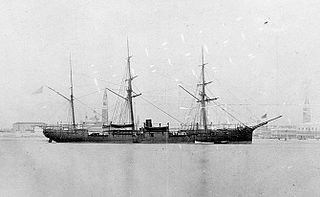
The second USS Ticonderoga was a 2526-ton Lackawanna-class screw sloop-of-war laid down by the New York Navy Yard in 1861; launched on 16 October 1862; sponsored by Miss Katherine Heaton Offley; and commissioned at New York on 12 May 1863, Commodore J. L. Lardner in command.

The first USS Pawnee was a sloop-of-war in the United States Navy during the American Civil War. She was named for the Pawnee Indian tribe.

The first USS Pensacola was a screw steamer that served in the United States Navy during the U.S. Civil War.

USS Hendrick Hudson was a schooner-rigged screw steamer.
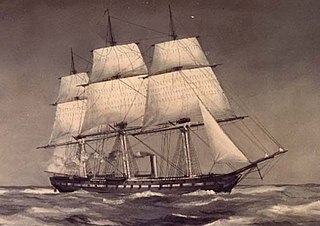
USS Wabash was a steam screw frigate of the United States Navy that served during the American Civil War. She was based on the same plans as Colorado. Post-war she continued to serve her country in European operations and eventually served as a barracks ship in Boston, Massachusetts, and was sold in 1912.
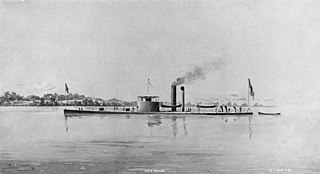
The first Passaic was a single turreted, coastal monitor purchased by the United States Navy for service during the American Civil War.

USS Richmond was a wooden steam sloop in the United States Navy during the American Civil War.

USS Stars and Stripes was a 407-ton steamer acquired by the U.S. Navy and put to use by the Union during the American Civil War.

The first USS Ossipee was a wooden, screw sloop-of-war in commission in the United States Navy at various times between 1861 and 1889. She served in the Union Navy during the American Civil War. She was named for the Ossipee River of New Hampshire and Maine. The USS Ossipee was present during the Alaska Purchase.
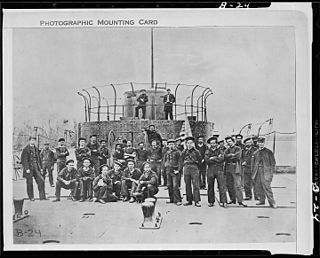
The first USS Lehigh was a Passaic-class monitor launched 17 January 1863 by Reaney, Son & Archbold, Chester, Pennsylvania, under a subcontract from John Ericsson; and commissioned at Philadelphia Navy Yard 15 April 1863, Commander John Guest in command.

Stephen Decatur Trenchard was a rear admiral in the United States Navy. He was present at the Battle of Taku Forts in 1859, and commanded the supply ship and gunboat Rhode Island throughout the American Civil War, seeing action at both Battles of Fort Fisher. He later commanded the North Atlantic Squadron.

USS Young America was a Confederate steamer captured by the Union Navy’s blockade vessels, and subsequently placed in-service in the Union Navy during the American Civil War.
USS Whitehall was a steamer acquired by the Union Navy during the American Civil War. She was assigned blockade duty; however, her condition was not always considered seaworthy, and she was plagued with condition problems.
USS John L. Lockwood was a steamer acquired by the Union Navy during the American Civil War. She was needed by the Navy to be part of the fleet of ships to prevent blockade runners from entering ports in the Confederacy.
USS Zouave was a steamer acquired by the Union Navy during the American Civil War. She was needed by the Navy to be part of the fleet of ships to prevent blockade runners from entering ports in the Confederacy.
USS Mount Washington was a steamer purchased by the Union Navy during the American Civil War. She was used by the Union Navy as a gunboat assigned to patrol Confederate waterways.

John Pyne Bankhead (1821–1867) was an officer in the United States Navy who served during the American Civil War, and was in command of the ironclad USS Monitor when it sank in 1862. He went on to command three other ships.

John Cummings Howell was an officer in the United States Navy during the American Civil War. He rose to the rank of rear admiral and late in his career was commander-in-chief of the North Atlantic Squadron and then of the European Squadron.

